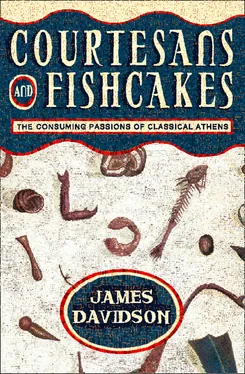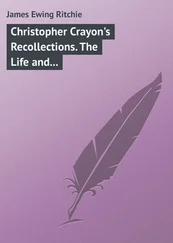The horn-shaped vessels called rhyton and keras belong to the same capacious category. A fragment of Epinicus describes three cups of legendary capacity, all of them rhyta. One holding two choes , approximately twelve pints, is known as the elephant tusk, to be drunk, apparently, in one go. At least one other source refers to such a vessel; it may be more than a figment of comedy’s hyperbolic imagination. Drinking-horns share the kantharos ’ symbolic associations with Dionysus and his retinue, indicating in particular a primitive or barbarian approach to drinking. Often, it seems, they were filled with akratos . One striking image from a vase of about 500 BCE shows a foreshortened symposiast dressed up for drinking like a Scythian, a huge drinking-horn silhouetted against him in the foreground. When someone in a comedy asks for a drinking-horn or even for ‘cups deeper to drink from than drinking-horns’, it is clear that the well-ordered Greek forms of drinking are being ushered out of the door. A striking illustration of this comes from the plastic vases, ceramic cups moulded into figures. The cups come in a variety of forms, but never assume the features of the white males for whose lips they were intended, a striking exception that François Lissarrague in his study of the imagery of the symposium thought significant: ‘there are no gods except for Dionysus and Heracles; instead one finds only women, both male and female blacks, Asians and satyrs … It is as if the anthropology of such moulded vases was meant to define the opposite of the Greek drinker and to hold up to him all the things that he was not.’ 43 Конец ознакомительного фрагмента. Текст предоставлен ООО «ЛитРес». Прочитайте эту книгу целиком, купив полную легальную версию на ЛитРес. Безопасно оплатить книгу можно банковской картой Visa, MasterCard, Maestro, со счета мобильного телефона, с платежного терминала, в салоне МТС или Связной, через PayPal, WebMoney, Яндекс.Деньги, QIWI Кошелек, бонусными картами или другим удобным Вам способом.
It is no coincidence that the cups most often used for refashioning into the form of these notoriously immoderate drinkers are the cups of immoderate drinking, the kantharos and the horn being particular favourites for makeover.
Drinking-horns presented something of a problem for moralists. For if, as the philosopher Chamaeleon of Heracleia insisted, in his treatise On Drunkenness , big cups were an invention of modern decadence and did not exist in earlier times, how was it that the rhyton was an attribute of the heroes of the past? The philosopher had an answer for this objection. The artists represent heroes with large cups, so that it will be seen that their characteristic rage is due not to their temperamental nature, but to their inebriation. 44 Конец ознакомительного фрагмента. Текст предоставлен ООО «ЛитРес». Прочитайте эту книгу целиком, купив полную легальную версию на ЛитРес. Безопасно оплатить книгу можно банковской картой Visa, MasterCard, Maestro, со счета мобильного телефона, с платежного терминала, в салоне МТС или Связной, через PayPal, WebMoney, Яндекс.Деньги, QIWI Кошелек, бонусными картами или другим удобным Вам способом.
Other rather more obscure shapes share the reputation of the kantharos and the rhyton. The kumbion was a deep vessel shaped like a boat, a favourite shape of one notorious drinker in the fourth century, known as Euripides. Another deep cup called lepastē was associated with the verb laptō , which Athenaeus glosses as ‘to drink in one go’. A fragment of Pherecrates has a character offering one to the thirsty members of his audience suggesting they swig it like Charybdis. Elsewhere, we find it emptied by old women, and used successfully to charm Lysander when a kōthōn had failed. One of thesedeep cups is actually called a ‘breathless cup’, because its contents were drunk down without a breath. 45 Конец ознакомительного фрагмента. Текст предоставлен ООО «ЛитРес». Прочитайте эту книгу целиком, купив полную легальную версию на ЛитРес. Безопасно оплатить книгу можно банковской картой Visa, MasterCard, Maestro, со счета мобильного телефона, с платежного терминала, в салоне МТС или Связной, через PayPal, WebMoney, Яндекс.Деньги, QIWI Кошелек, бонусными картами или другим удобным Вам способом.
Despite the competition, it is Critias’ kōthōn that comes to stand par excellence for deep drinking at Athens. It shares many of the features of those deep cups associated with Dionysus and his followers, emptied in single draughts. A kōthōn referred to in a play of Alexis could hold about two pints. In a painting described by Polemon in a fragmentary ecphrasis from his To Adaeus and Antigonus , Dionysus is seated on a rock accompanied by a bald-headed satyr holding a kōthōn . A woman in Theopompus’ Stratiotides describes the customary way this cup was drained: ‘I, for one, would be prepared to stretch back my throat to drink from the neck-twisting kōthōn .’ Most commentators suggest that this comic drama played on the consequences of the fantastic scenario of women in the army, and there seems to be more to the kōthōn , s military connection than special pleading on the part of Critias. They are found in the hands of soldiers in Archilochus’ early archaic Elegies , and in Aristophanes’ late-fifth-century Knights . However, contra Critias, the liquid most likely to be discovered inside was not water but wine. There has been some debate over what the Spartan cup actually looked like. Many have been misled by Critias’ description to look in vain for a vessel with an elaborate folded-over rim to catch impurities. But the fragment refers more simply to ambōnas , meaning ‘ridges’ or ‘ribs’. At least one vase, shaped like a stout mug or tankard, has been discovered with kōthōn actually written on the base, and it now seems clear that this shape satisfies most of the literary references. By Critias’ time at the end of the fifth century they were being made with vertical ridges all the way round. Normally such ridging was simply decorative, an attempt to make ceramic ware look like silver, but on the kōthōns the ridging is often found on the inside too, apparently a rather pointless exercise that would only weaken the fabric. Some students of vases have suggested this could only be explained as an obsession with imitating metalware taken to counter-productive extreme. But Critias explains it much better. What is the point of having ridges to collect the lees unless you have them on the inside? 46 Конец ознакомительного фрагмента. Текст предоставлен ООО «ЛитРес». Прочитайте эту книгу целиком, купив полную легальную версию на ЛитРес. Безопасно оплатить книгу можно банковской картой Visa, MasterCard, Maestro, со счета мобильного телефона, с платежного терминала, в салоне МТС или Связной, через PayPal, WebMoney, Яндекс.Деньги, QIWI Кошелек, бонусными картами или другим удобным Вам способом.
If such vessels are rarely mentioned in modern accounts of Greek drinking it is because they do not fit the image of the classic elegant sympotic cup, looking more like a medieval tankard. Beazley, the great connoisseur of Greek pots, preferred to leave them nameless, classifying them (despite their lack of a pouring-spout) with jugs.
Читать дальше












